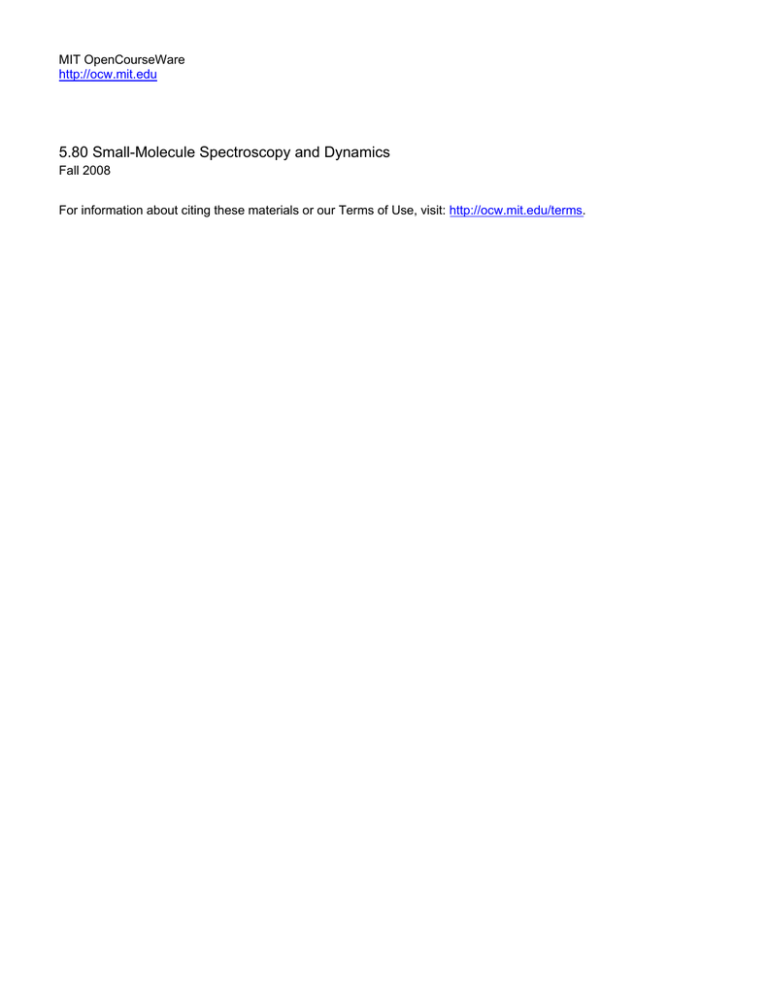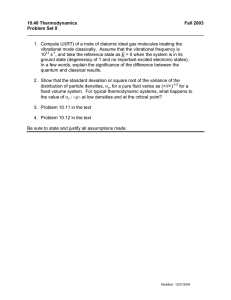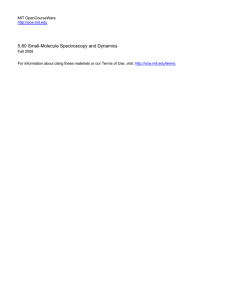5.80 Small-Molecule Spectroscopy and Dynamics MIT OpenCourseWare Fall 2008
advertisement

MIT OpenCourseWare http://ocw.mit.edu 5.80 Small-Molecule Spectroscopy and Dynamics Fall 2008 For information about citing these materials or our Terms of Use, visit: http://ocw.mit.edu/terms. MASSACHUSETTS INSTITUTE OF TECHNOLOGY Chemistry 5.76 Spring 1994 Problem Set #4 Questions 1-3 deal with the geometric and vibrational structure of water. All relevant information is given in the “FG Treatment of H2 O” handout. 1. The microwave spectrum of H2 O. (a) What kind of top is H2 O? (b) Along which principal axis is the electric dipole moment aligned? (c) What are the selection rules for the pure rotation spectrum of H2 O? (d) Compute the frequencies (in GHz) of all electric dipole allowed J = 4 ← 4 and J = 5 ← 4 transitions of H2 O. (e) Is T2 O a near prolate or a near oblate top? If it is near prolate, at what bond angle would T2 O switch from near prolate to near oblate? (f) What would the selection rules be for the pure rotation spectrum of near oblate T2 O? (g) When a bending vibration is excited, the water molecule spends most of each vibrational period near the turning points (one near linear, the other strongly bent). Qualitatively, how would you expect the pure rotation spectrum of T2 O to evolve in successively higher overtone vibrational levels of the bending vibration? 2. The vibrational spectrum of HDO. (a) Predict the normal mode frequencies of HDO. (b) Describe each of the three normal modes as an explicit linear combination of the HO and DO stretches and the HDO bend internal coordinates. Do this in terms of both equations and displacement vectors. (c) How many of the 3 v = 1 ← 0 vibrational fundamentals of HDO will be electric dipole allowed transi­ tions? Why? (d) Draw a picture of the equilibrium structure of HDO on which you label the directions of the a, b, c principal inertial axes and the permanent electric dipole moment. (e) From your pictures of the three normal modes [part 2(b)], using a bond moment model for the electric dipole moment (the dipole moment is the vector sum of two identical bond moments which lie along the bond), what can you say about the rotational selection rules for each of the three vibrational fundamental 5.76 Problem Set #4 Spring, 1994 page 2 bands. [HINT: estimate which component of the dipole moment changes the most for each vibrational normal mode. Assume that each bond moment varies linearly with bond length.] 3. G Matrices (a) Write the G matrix for the trans-bent excited state of acetylene: 120◦ H � � C C � � H rCH = 1.06Å rCC = 1.39Å (b) Write the G matrix for the non-planar excited state of formaldehyde: H 119◦ H � � C O � 31◦ �� H H � � � �� C rCH = 1.09Å O rCO = 1.32Å 4. Bernath, Chapter 7, Problem #13, page 278. The following table gives the fundamentals and combination bands in the infrared spectrum of acetylene. Fundamentals are very strong (vs), combination lines involving only two fundamentals are of medium (m) intensity, and all others are weak (w). In this slightly idealized version of the spectrum, anharmonicity effects do not occur and v4 < v5 < v2 < v3 < v1 . Determine the frequencies of the fundamentals and assign the combination bands. Band position Intensity 730 vs 1340 m 1950 w 2700 m 3290 vs 3310 w 3900 m 4100 m 5260 m 6660 m cm−1 5. Bernath, Chapter 7, Problem #19, page 280. The infrared spectrum of N2 O has three fundamental bands. Assuming that the structure of N2 O is linear, explain how this spectrum allows you to distinguish between the N—N—O and the N—O—N structures. Sketch the approximate atomic motions of the normal modes. 5.76 Problem Set #4 Spring, 1994 page 3 6. Bernath, Chapter 7, Problem #21, page 280. The following bands have been measured in the infrared spectrum of a bent AB2 molecule: Frequency (cm−1 ) 1200 2400 2670 3500 Intensity vs m vs vs Frequency (cm−1 ) 3600 3870 4700 4800 Identify the fundamental, overtone, and combination bands. Intensity w m m s





